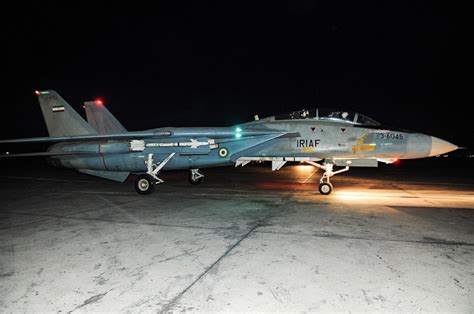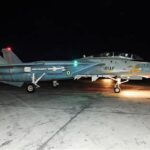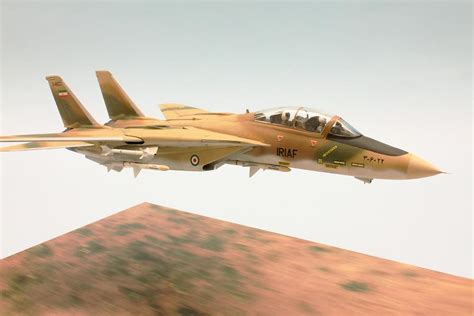
A recent Israeli airstrike has reportedly decimated a significant portion of Iran’s F-14 “Persian Tomcat” fleet, severely degrading the Islamic Republic’s air defense capabilities, according to unconfirmed reports circulating within military and intelligence communities. The extent of the damage and the location of the alleged strike remain shrouded in secrecy, but the potential loss of these iconic aircraft represents a critical blow to Iran’s aging air force.
Details of the Alleged Airstrike
Reports indicate that the Israeli Air Force (IAF) executed a precision strike targeting a major Iranian airbase believed to house a substantial number of operational F-14 Tomcats. These aircraft, acquired before the 1979 Islamic Revolution, have been meticulously maintained and upgraded over the years, forming a crucial component of Iran’s defensive posture against potential aerial threats. While neither Israeli nor Iranian officials have officially commented on the incident, the lack of a swift and definitive denial from Tehran has fueled speculation and heightened concerns about regional stability.
The airstrike, if confirmed, would represent a significant escalation in the ongoing shadow war between Israel and Iran. The two nations have been engaged in a protracted struggle for regional dominance, with Israel primarily focused on preventing Iran from developing nuclear weapons and curtailing its support for proxy groups across the Middle East. Iran, on the other hand, views Israel as an illegitimate entity and has repeatedly vowed to retaliate against any aggression.
The exact number of F-14s destroyed in the alleged strike remains unconfirmed. Some sources suggest that upwards of half of Iran’s operational fleet may have been taken out of service. This would not only impact Iran’s ability to project power in the region but also create a significant gap in its air defense network, particularly along its western border.
Iran’s F-14 Tomcat Fleet: A Storied History
The F-14 Tomcat holds a special place in aviation history, renowned for its variable-sweep wings, powerful radar, and long-range air-to-air missiles. Originally designed to defend U.S. Navy aircraft carrier battle groups from Soviet bombers, the F-14 gained iconic status through its starring role in the 1986 film “Top Gun.”
Iran acquired 80 F-14A Tomcats from the United States in the 1970s, along with a vast inventory of AIM-54 Phoenix missiles. This acquisition significantly bolstered the Imperial Iranian Air Force’s capabilities, providing it with a long-range interceptor capable of engaging multiple targets simultaneously. After the 1979 revolution, the U.S. imposed an arms embargo on Iran, preventing it from acquiring spare parts and new aircraft.
Despite these challenges, Iran managed to keep a number of its F-14s operational through a combination of reverse engineering, cannibalization of parts, and procurement from the black market. The Iranian Air Force even managed to develop its own indigenous air-to-air missiles to replace the aging AIM-54 Phoenix.
Over the years, the Iranian F-14 fleet has undergone several upgrades to enhance its capabilities. These upgrades have included the integration of new radar systems, avionics, and electronic warfare suites. The aircraft have also been modified to carry a wider range of air-to-ground weapons, making them more versatile in both air defense and ground attack roles.
Implications for Regional Security
The alleged destruction of Iran’s F-14 fleet has significant implications for regional security. It weakens Iran’s air defenses, making it more vulnerable to potential airstrikes from Israel or other adversaries. It also reduces Iran’s ability to project power in the region, potentially emboldening its rivals.
The incident could also escalate tensions between Israel and Iran, potentially leading to further military confrontations. Israel has repeatedly stated that it will not allow Iran to develop nuclear weapons and is prepared to take military action to prevent it. Iran, on the other hand, has vowed to retaliate against any attack on its nuclear facilities or other strategic assets.
The destruction of the F-14 fleet could also prompt Iran to seek new sources of advanced fighter aircraft. Russia and China are potential suppliers, and Iran may attempt to acquire Su-30 or J-10 fighters to replace its lost Tomcats. Such a move would further complicate the regional security landscape and potentially trigger a new arms race.
Israel’s Strategic Objectives
Israel’s alleged airstrike on Iran’s F-14 fleet is consistent with its long-standing strategy of preventing Iran from acquiring advanced military capabilities that could threaten its security. Israel views Iran as its primary strategic adversary and has been actively working to counter its influence in the region.
In recent years, Israel has conducted numerous airstrikes in Syria targeting Iranian military installations and weapons shipments destined for Hezbollah, a Lebanese Shiite militant group. Israel has also been accused of carrying out cyberattacks and sabotage operations against Iran’s nuclear program.
Israel’s strategy is based on the belief that Iran is determined to acquire nuclear weapons and that it poses an existential threat to the Jewish state. Israel has repeatedly stated that it will not allow Iran to develop nuclear weapons and is prepared to take military action to prevent it.
Iran’s Response Options
If the reports of the Israeli airstrike are confirmed, Iran will face a difficult decision on how to respond. It could choose to retaliate directly against Israel, potentially triggering a full-scale war. Alternatively, it could opt for a more indirect approach, such as increasing its support for proxy groups or launching cyberattacks against Israeli targets.
Iran could also choose to pursue diplomatic options, such as appealing to the United Nations Security Council or seeking mediation from other countries. However, given the deep distrust between Israel and Iran, a diplomatic resolution seems unlikely.
Regardless of its response, Iran will likely seek to rebuild its air defenses as quickly as possible. This could involve acquiring new fighter aircraft from Russia or China, as well as strengthening its air defense missile systems.
International Reactions
The alleged Israeli airstrike on Iran’s F-14 fleet has drawn condemnation from some countries and expressions of concern from others. Many countries have called for restraint and urged both Israel and Iran to avoid escalating the conflict.
The United States, Israel’s closest ally, has not officially commented on the incident. However, it is widely believed that the U.S. was informed in advance of the Israeli airstrike. The U.S. has a long-standing policy of supporting Israel’s right to defend itself and has provided Israel with billions of dollars in military aid.
Russia, a key ally of Iran, has condemned the alleged Israeli airstrike and called for an immediate investigation. Russia has also warned Israel against taking any further military action against Iran.
China, another major power, has expressed concern about the escalating tensions in the Middle East and has called for a peaceful resolution to the conflict. China has close economic ties with Iran and is a major importer of Iranian oil.
The Future of the Iranian Air Force
The destruction of Iran’s F-14 fleet represents a significant setback for the Iranian Air Force. However, it is unlikely to cripple its air defense capabilities entirely. Iran still possesses a number of other fighter aircraft, including MiG-29s, Su-22s, and F-4 Phantoms.
Iran is also investing heavily in the development of its own indigenous fighter aircraft. The Kowsar is a domestically produced jet trainer and light attack aircraft that is based on the American F-5. Iran is also working on a more advanced fighter aircraft called the Qaher-313, which is designed to be a stealth fighter.
In the long term, the future of the Iranian Air Force will depend on its ability to acquire new fighter aircraft from Russia or China, as well as its success in developing its own indigenous aircraft. It will also depend on the political and economic situation in Iran, as well as the level of international pressure on the country. The loss of the F-14 fleet will undoubtedly accelerate Iran’s efforts to modernize its air force and reduce its reliance on foreign suppliers.
Analysis and Context
The reported destruction of Iran’s F-14 fleet underscores the volatile security environment in the Middle East and the ongoing strategic competition between Israel and Iran. While the immediate impact is a degradation of Iran’s air defense capabilities, the longer-term consequences could be far more significant. The incident could trigger an escalation of the shadow war between the two countries, leading to further military confrontations and potentially destabilizing the entire region.
The alleged airstrike also highlights the limitations of Iran’s aging air force. Despite years of effort to maintain and upgrade its existing aircraft, Iran has struggled to keep pace with the technological advancements of its rivals. The destruction of the F-14 fleet will likely accelerate Iran’s efforts to modernize its air force, but this will be a costly and time-consuming process.
Furthermore, the incident raises questions about the effectiveness of international arms embargoes. Despite decades of sanctions, Iran has managed to maintain a significant military capability. This suggests that arms embargoes alone are not sufficient to prevent countries from acquiring advanced weapons.
The situation requires careful monitoring and a concerted effort by the international community to de-escalate tensions and promote dialogue between Israel and Iran. A failure to do so could have catastrophic consequences for the region and the world. The “decimated” fleet represents more than just lost aircraft; it symbolizes a potential shift in the regional power balance and a heightened risk of conflict. The lack of confirmation from official sources adds another layer of complexity to the situation, making it difficult to assess the true extent of the damage and the likely consequences. The coming weeks and months will be crucial in determining whether this incident leads to further escalation or a renewed effort to find a diplomatic solution to the ongoing conflict between Israel and Iran.
The implications extend beyond the immediate military impact. The destruction of such an iconic aircraft – a symbol of Iranian air power for decades – could have a significant psychological effect on the Iranian military and population. It could also embolden Israel and its allies, potentially leading to further aggressive actions.
The international community will be watching closely to see how Iran responds. A measured and calculated response could help to de-escalate tensions, while a more aggressive response could trigger a wider conflict. The stakes are high, and the consequences of miscalculation could be dire.
The incident also serves as a reminder of the importance of air power in modern warfare. The ability to control the skies can provide a significant advantage in any conflict. The destruction of Iran’s F-14 fleet weakens its ability to defend its airspace and project power in the region.
The Role of Intelligence
The accuracy and reliability of the intelligence leading to the alleged strike are critical factors. If the intelligence was faulty or outdated, the airstrike could have unintended consequences. It could also damage Israel’s credibility and undermine its ability to conduct future operations.
The incident also highlights the importance of intelligence sharing between allies. Israel and the United States have a long history of intelligence cooperation, and it is likely that the U.S. provided Israel with valuable information about Iran’s F-14 fleet.
The success of the airstrike, if confirmed, would be a testament to the effectiveness of Israel’s intelligence gathering capabilities. It would also demonstrate the ability of the Israeli Air Force to conduct precision strikes against heavily defended targets.
FAQ
1. Has the Israeli government confirmed the airstrike on Iran’s F-14 fleet?
No. As of now, there is no official confirmation from the Israeli government regarding the airstrike. The reports are circulating within military and intelligence communities but remain unverified by official sources.
2. What is the current state of Iran’s air force following the alleged strike?
While the full extent of the damage is still unknown, the alleged destruction of a significant portion of the F-14 fleet would severely degrade Iran’s air defense capabilities. The Iranian Air Force would need to rely more heavily on its other fighter aircraft, such as MiG-29s and F-4 Phantoms, and potentially seek to acquire new aircraft from Russia or China.
3. What are the potential consequences of this alleged attack on the relationship between Iran and Israel?
The incident could significantly escalate tensions between Israel and Iran, potentially leading to further military confrontations or an intensification of the ongoing shadow war. It could also prompt Iran to retaliate against Israel or its allies, either directly or through proxy groups.
4. How did Iran acquire the F-14 Tomcats in the first place?
Iran acquired 80 F-14A Tomcats from the United States in the 1970s, prior to the Islamic Revolution. This was part of a larger arms deal between the two countries when they were allies. After the revolution, the U.S. imposed an arms embargo on Iran, preventing it from acquiring spare parts and new aircraft.
5. What are Iran’s options for replacing the lost F-14 Tomcats?
Iran could potentially acquire new fighter aircraft from Russia or China, such as the Su-30 or J-10. It could also continue to develop its own indigenous fighter aircraft, such as the Kowsar and the Qaher-313. However, these options may be limited by international sanctions and technological challenges.
Additional Contextual Information:
The geopolitical landscape of the Middle East is characterized by a complex interplay of factors, including religious divisions, historical grievances, competition for resources, and the involvement of external powers. The rivalry between Israel and Iran is a central element of this landscape.
Israel views Iran as an existential threat due to its nuclear ambitions, its support for anti-Israel militant groups, and its repeated calls for Israel’s destruction. Iran, in turn, views Israel as an illegitimate entity and a key obstacle to its regional aspirations.
The two countries have been engaged in a shadow war for years, involving covert operations, cyberattacks, and proxy conflicts. The alleged airstrike on Iran’s F-14 fleet represents a significant escalation of this conflict, potentially bringing the two countries closer to a direct military confrontation.
The role of the United States in the region is also a crucial factor. The U.S. is Israel’s closest ally and has provided it with billions of dollars in military aid. The U.S. has also been a vocal critic of Iran’s nuclear program and its support for terrorism.
The international community as a whole has a responsibility to de-escalate tensions and promote dialogue between Israel and Iran. A failure to do so could have catastrophic consequences for the region and the world.









